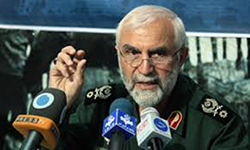{{currentView.title}}
October 09, 2015
Iran loses a key player in its Syria strategy
 |
The IRGC and Iran just suffered a big blow in the death of Brigadier General Hossein Hamedani on October 8 in Syria. Hamedani was a central figure in the IRGC and a possible successor to current IRGC Commander Mohammad Ali Jafari. He helped Jafari restructure the IRGC to ensure regime survivability in 2007. He was also an architect of the military-paramilitary-militia structures that have kept the Assad regime alive in Syria. His death may disrupt Iranian efforts in Syria and possibly throughout the region. It could also create opportunities that the U.S. and our allies could exploit.
So why does his death matter? Hamedani has been the IRGC’s operations lead in Syria since at least 2012. His presence there has allowed Qods Force Commander Qassem Soleimani to split his attention between Syria, Iraq, Yemen, and the various other regional and global issues he handles. His death will likely force Soleimani to focus on Syria, possibly distracting him from these other activities.
Hamedani was more than a reliable deputy to Soleimani. He was an innovator who refined and expanded the IRGC’s efforts to spread Iran’s model of combined military, paramilitary, and militia forces in Syria. He formed a paramilitary organization called “Sons of Jihad” in Syria this year, modeled on Iran’s Basij Resistance Force. He also formed organizations such as the “Keshaab”, an interfaith youth group purportedly aimed at strengthening unity and spirituality among Syria’s Alawites, Christians, and Sunnis, as well as promoting the Islamic Republic's revolutionary values.
Hamedani was also a central figure in the IRGC restructuring of 2007-2008. Supreme Leader Ayatollah Ali Khamenei asked General Jafari to establish an IRGC think-tank in 2005 to develop a new model for the organization of the IRGC. Jafari, working closely with Hamedani as his deputy, produced a new IRGC model to decentralize the IRGC command and its units to ensure that they could continue to operate in the face of a decapitation air-strike or internal unrest. It proved its worth in helping the regime crush the protests following the re-election of President Mahmoud Ahmadinejad.
Few people have the intellectual breadth to go from re-designing the structure of a national military to creating ad hoc structures integrating IRGC forces, Lebanese Hezbollah regulars, Syrian Arab Army troops, Iraqi militias, and Syrian irregular forces. Iranian planning and operations in Syria and around the region may be disrupted as the IRGC works to replace Hamedani. The U.S. and its partners could benefit from even a brief loss of Iranian momentum in Syria.
